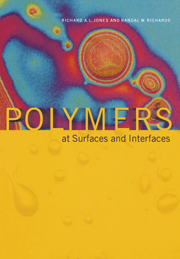Book contents
- Frontmatter
- Contents
- Preface
- 1 Introduction and overview
- 2 The surface of a simple polymer melt
- 3 Experimental techniques
- 4 Polymer/polymer interfaces
- 5 Adsorption and surface segregation from polymer solutions and mixtures
- 6 Tethered polymer chains in solutions and melts
- 7 Adhesion and the mechanical properties of polymer interfaces at the molecular level
- 8 Polymers spread at air/liquid interfaces
- Index
4 - Polymer/polymer interfaces
Published online by Cambridge University Press: 19 January 2010
- Frontmatter
- Contents
- Preface
- 1 Introduction and overview
- 2 The surface of a simple polymer melt
- 3 Experimental techniques
- 4 Polymer/polymer interfaces
- 5 Adsorption and surface segregation from polymer solutions and mixtures
- 6 Tethered polymer chains in solutions and melts
- 7 Adhesion and the mechanical properties of polymer interfaces at the molecular level
- 8 Polymers spread at air/liquid interfaces
- Index
Summary
Introduction
In technology the use of pure materials is rare. The idea that, in order to get desired properties, one needs to use not pure materials but mixtures dates to prehistoric times, when it was discovered how much more useful copper was if tin were added to make bronze. So it is a natural idea to assume that one can broaden the range of materials that can be made from a few basic polymer types by mixing or blending these basic types together. However, it turns out not to be so easy; if you take a pair of common polymers, poly(methyl methacrylate) and polystyrene, say, and mechanically mix them, you get a very brittle material whose properties are generally much worse than those of either of the pure ingredients. The reason for this is fairly clear — examination of the resulting material reveals that the two polymers separate to form coarse domains of pure polymer; there is no intimate mixing between the components. Moreover, the interface between the domains is very weak. The difficulty of making a strong bond between two polymers is something most people are familiar with; joining two different plastics is usually difficult with most glues, which form weak joints with plastics.
- Type
- Chapter
- Information
- Polymers at Surfaces and Interfaces , pp. 127 - 186Publisher: Cambridge University PressPrint publication year: 1999
- 1
- Cited by



